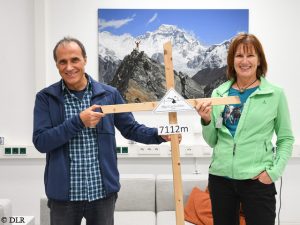Prince and princess in the hypoxia chamber
Bottled oxygen on a mountain has always been out of the question for me. On principle. Today I made an exception – for a “virtual mountain”. To be able to visit Ralf Dujmovits, the only German mountaineer who has scaled all 14 eight-thousanders, and his partner, the Canadian climber Nancy Hansen, it is mandatory to use a breathing mask. After two weeks in the hypoxia chamber of the German Aerospace Center (DLR) in Cologne, the two test persons have reached the simulated target altitude of 7,112 meters. The percentage of oxygen in the air, normally 21 percent, was gradually reduced to eight percent by adding nitrogen. “It’s like climbing a mountain. The acclimatization is almost done, now we’re heading for the summit,” says Ralf. “The time on the summit will be of course much longer.”
Short rest, then things gets serious
In the coming days, Ralf and Nancy can once again briefly “descend” to breathe thicker air. On 4 June, however, the crucial phase of the study will begin, during which the two climbers are to stay constantly at a simulated altitude of 7,112 metres for two weeks. The aim is to test whether extreme hypoxia can strengthen the heart and even lead to the formation of new cells. If this finding from experiments with mice can be confirmed in humans, completely new therapeutic approaches would be conceivable for heart attack patients.
How much physical deterioration will there be?
“We are both excited,” reveals Nancy. “I think the first few days will be okay. And then either it will feel normal or we start to deteriorate. Nobody really knows.“ Ralf recalls the French climber Nicolas Jaeger, who in 1979 in a self experiment spent two months alone in the summit area of the 6,768-metre-high Huascaran in Peru: “Cognitively he felt not so bad. In the end, physical deterioration became the major problem for him. I expect the same from us. We’re probably going to lose a lot of muscle.”
Breathe properly
So far, Hansen and Dujmovits have coped well with the low-oxygen time in the DLR’s hypoxia chamber. In any case, you can’t see yet what a burden they’re under. “I had three, four pretty bad headaches, mostly in the night,” says Nancy. “But it has gotten better.” The 49-year-old Canadian finds it fascinating to see “what’s happening inside of our bodies, also in comparison between Ralf and I”. Her partner acclimatizes much better than her, says Nancy: “The way his lungs exchange oxygen with his heart is very different to my exchange. Ralf is teaching me how to breathe properly in here.”
Currently no climbing wall training
Dujmovits estimates that he has now lost “40 to 45 percent performance”. Dosed endurance training on the bicycle ergometer or the treadmill is still possible at the current simulated altitude of around 7,000 meters, says the 56-year-old. However, the two are currently stay well clear of the mobile climbing wall in the hypoxia chamber. “The strain on the muscles is much greater, and we get very quickly into the anaerobic phase. But we want to avoid an oxygen defiency that would cause immediately headaches,” says Ralf.
No cabin fever
I ask whether the relationship of the two test persons is put to a serious test by the long time in the hypoxia chamber? “Not so far,” Nancy replies, laughing. “We spend so much time together. There are no problems at all, and I don’t expect any.” Ralf nods. “I think it’s important to keep stress out of a relationship. We’ve done quite well so far.”
No Big Brother
Even the constant camera surveillance doesn’t bother them anymore. “We’re not making ‘Big Brother’ here,” says Dujmovits. “We know that the scientists are trustworthy with everything that can be seen here.” Meanwhile they almost ignore the cameras’ existence. “This morning I was just walking around the rooms in my underpants. Only on my way back I realized that everyone in the surveillance room could see me like this.” Ralf emphasizes that the whole experiment is “a team effort”. The climber specifically praises the committed DLR scientists: “They are here for us 24 hours a day in an all-round shift work.” Nancy is also enthusiastic about the team. “All the staff here have been treating us so well. We feel really like a prince and a princess.”












